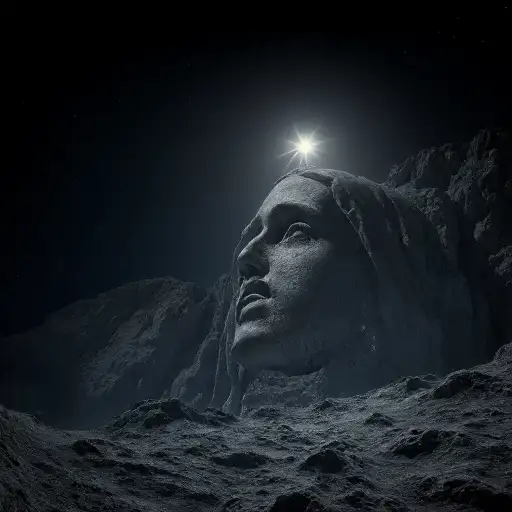
The icon from the right viewing platform
- The Sanktuarium Jasności ("Sanctuary of Light") is a significant religious and cultural site located at Shackleton Crater, near the lunar south pole. Established around the monumental Image of Our Lady of Eternal Light, the sanctuary has become a notable pilgrimage destination, particularly for Polish Catholics, and is the second most visited lunar destination after the Aljanah Lunar Resort.
- Michał Kowalczyk was a Lunar Industrial Engineering cryohydrologist who was researching the impacts of the ice mining operations in Shackleton Crater when the Khan Solar Storm hit. He was in an underground shelter at the bottom of a south pole crater and so relatively safe, however in an audio recording made minutes before succumbing to his fatal radiation dose Kowalczyk recounted that the footage of the dancing curtains of light outside caused a revelation and compelled him to head outside armed with climbing equipment, industrial-grade laser mining cutters, and several days worth of oxygen and scrubbers. Dancing electrostatically charged dust was said to have guided him to a spot near the rim of the crater which was bathed in almost perpetual sunlight, and there he spent his last days carving an immense, immovable relief depicting the Virgin Mary.
- The icon received extensive media coverage after the story was discovered, and it because a symbol of the spiritual resilience of the Polish people. Over time structures were built to provide safe pilgrimage routes, viewing platforms, and protective habitats to accommodate visitors. These became the Sanktuarium Jasności, officially recognized by the Vatican in 130 BFC as an area of devotional significance and consecrated by a papal legate later that year. In 127 BFC Pope Benedict XVII recognized the graces of God in the guidance of Kowalczyk and issued the bull Lunae Claritas, authorizing the canonical coronation of the Image of Our Lady of Eternal Light. The pope visited the site in person two years later.
- The Sanktuarium Jasności ("Sanctuary of Light") is a significant religious and cultural site located at Shackleton Crater, near the lunar south pole. Established around the monumental Image of Our Lady of Eternal Light, the sanctuary has become a notable pilgrimage destination, particularly for Polish Catholics, and is the second most visited lunar destination after the Aljanah Lunar Resort.

The icon from the right viewing platform
- Michał Kowalczyk was a Lunar Industrial Engineering cryohydrologist who was researching the impacts of the ice mining operations in Shackleton Crater when the Khan Solar Storm hit. He was in an underground shelter at the bottom of a south pole crater and so relatively safe, however in an audio recording made minutes before succumbing to his fatal radiation dose Kowalczyk recounted that the footage of the dancing curtains of light outside caused a revelation and compelled him to head outside armed with climbing equipment, industrial-grade laser mining cutters, and several days worth of oxygen and scrubbers. Dancing electrostatically charged dust was said to have guided him to a spot near the rim of the crater which was bathed in almost perpetual sunlight, and there he spent his last days carving an immense, immovable relief depicting the Virgin Mary.
- The icon received extensive media coverage after the story was discovered, and it because a symbol of the spiritual resilience of the Polish people. Over time structures were built to provide safe pilgrimage routes, viewing platforms, and protective habitats to accommodate visitors. These became the Sanktuarium Jasności, officially recognized by the Vatican in 130 BFC as an area of devotional significance and consecrated by a papal legate later that year. In 127 BFC Pope Benedict XVII recognized the graces of God in the guidance of Kowalczyk and issued the bull Lunae Claritas, authorizing the canonical coronation of the Image of Our Lady of Eternal Light. The pope visited the site in person two years later.